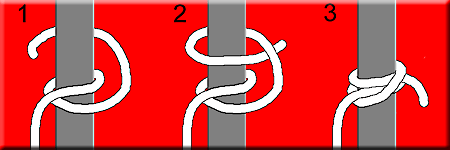
Clove Hitch

- even
though there may be better knots for tying to square shapes or for
better security, this can be a very useful knot. It is quick and very
simple to tie and untie. Just loop a rope around the post and over
itself. Then bring it around and under the rope as seen in the
picture.
Half Hitch

- this is basically the rope being tied around a post and itself, then under itself as you see here. However, not particularly secure. It is here to illustrate that it is the beginning of the Two Half Hitch.
Two Half Hitch
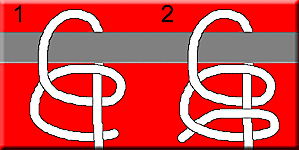
- you
may have already used this knot or have at least seen it. It is both
simple and secure but can be hard to untie. We apologize because
being able to untie a knot is a quality that makes a knot "good".
However, we could not leave this out simply because it is a more than
useful knot in many applications. Not to mention, the Slipped
variation can make this rather easy to untie anyway. This is only a
Half Hitch done twice. Please see the diagram.
Tautline Hitch
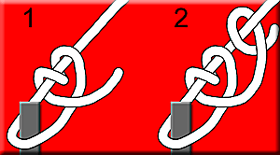
- this is used to keep rope tight when it sags over time. It holds in one direction and can be slid in the opposite direction to tighten the rope as needed. This one-way ratchet-action makes this one of our favorites. Used quite often to tie both ends of the canoe on top of our truck. You simply take the rope around the post. Around the rope twice, back down towards the post. Then back up over those two loops and around one more time as in the picture. Work it together and there it is.
Truckers Hitch
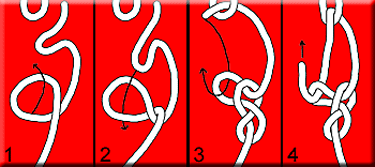
- this is actually a combination of knots. It is excellent for cinching down a load on a truck or car when you need a bit of leverage to get the job done. First start with the Bowline and we recommend following the illustrations from here as this can get very wordy and complicated. Practice this often, because this knot will be very useful to you if you do not own ratchet straps.
Timber Hitch
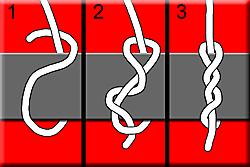
- this hitch looks too simple. It really is! Your friends will laugh at you when you tie it. But, it is secure if tied around a rough object where the direction of the pull will not be moving around. It also helps if the rope will be under constant strain too. Even though this can be secure, we do not recommend using it when security is the priority for you. Put the rope around a rough object and wrap the rope around itself several times as illustrated.
Rolling Hitch
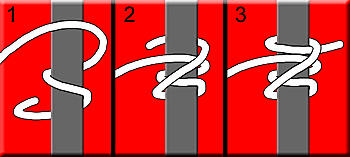
- here is another knot that is excellent for tying a rope to the middle of another rope (like the Sheet Bend). And yes, we realize this would then be a Bend. Nevertheless, a Hitch is what it is. This may be why this knot is best when the pull is lengthwise, up or down, on a pole. Take the rope around the pole a couple of times. Come back up over those two wraps and then back under the last wrap-around to lock the rope. The illustration shows it much better.